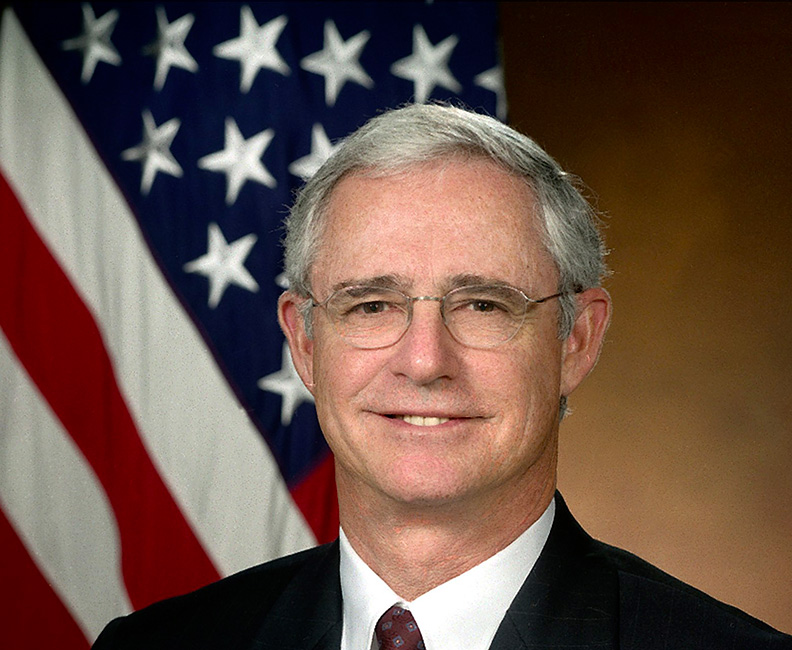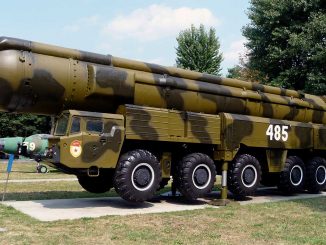Since our future military requirements are likely to be based on short-duration, regional conflicts using fully interoperable coalition forces operating modern-technology equipment and weapons systems that are fully interoperable, we must transform our defense industrial base to support us in this effort.
Remarks by The Honorable Jacques S. Gansler, Under Secretary of Defense (Acquisition and Technology), International Institute for Strategic Studies, Oxford, England, September 3, 1998. Source : DoD.
Introduction
Late last month, the American Secretary of State, in a televised statement reacting to the most recent wave of terrorism, warned the American public and the world community that we can expect to see more of the same in the future. Perhaps surprising to this group, the American media and public were alarmed by the scope of the problem and the need to take decisive action. Many commentators were surprised to learn that terrorism is no longer a passing phenomenon or a form of deadly aggression that we can counter simply by bringing individuals to justice.

Our collective public attention has obviously not focused on the vast, complex geopolitical, economic, and technological upheaval that is taking place in our world.
The recent terrorist bombings in Kenya and Tanzania, as well as the conflicts in Bosnia and Kosovo, have brought home to all of us the very different nature of the present and future threats to our national security.
The Honorable Jacques S. Gansler
Our collective public attention has obviously not focused on the vast, complex geopolitical, economic, and technological upheaval that is taking place in our world. The recent terrorist bombings in Kenya and Tanzania, as well as the conflicts in Bosnia and Kosovo, have brought home to all of us the very different nature of the present and future threats to our national security.
The Post Cold War Environment
Former U.S. Secretary of Defense, William Perry, recently said that « It is all too clear that terrorism is on the rise, and that any specific terrorist incident is very difficult to prevent, and almost impossible to deter, since we don’t know who we are deterring or what actions would constitute deterrence. » This much, however, is certain: we must assume that our enemies will increasingly seek to use weapons of mass destruction against us in future terrorist acts and we must do everything we can to keep these weapons and their means of delivery out of their hands.
While we cannot say for certain how this threat will evolve, it is unlikely to go away. In fact, if transnational terrorist elements and rogue nations shift to biological and chemical attacks (both at home and abroad) and attack our infrastructure with information warfare (for example, against our air traffic control systems and/or our electronic financial systems) the impacts are only likely to grow.
These terrorist threats (based on early 21st century technology) are, of course, only one end of the spectrum of future threats we must be prepared to face. In fact, we can expect a diverse and unpredictable threat — both asymmetrical and traditional; often combining more traditional conflict with acts of terrorism. And, even in the more « traditional » military areas (from small scale military operations on up to nuclear war), military conflict is being dramatically transformed by the rapidly changing nature of modern technology.
Of course, this is nothing new. Throughout history, advances in technology have directly and indirectly transformed the course of warfare. From spear and longbow, to the invention of gunpowder and dynamite, to the use of aircraft and the machine gun, and on to chemical and nuclear weapons and biological agents, we have seen how revolutionary advances in weaponry have influenced the nature and extent of combat. In spite of such advances, however, for centuries, the use of technology has primarily been to provide advantage to one side’s massed forces in its efforts to defeat the other side’s massed forces.
The « Revolution In Military Affairs »
All this is about to change. The end of the Cold War, the breakup of the Soviet Empire, the emerging power of rogue nations, the rise of transnational terrorism, and other equally destabilizing geopolitical events — accompanied by revolutionary changes in technology — are transforming our vision of 21st century security needs and military strategy. Two fundamental changes seem clear: first, we will see more short, intense regional conflicts. And, second, our military will seek to project power without putting a large number of forces at risk. Massed forces will be replaced by massed firepower precisely placed on targets. Modern, so-called « reconnaissance/ strike » warfare (often referred to as the essence of the « Revolution In Military Affairs ») is based on real-time, all-weather, accurate and secure information systems combined with long-range, unmanned, « brilliant », highly-lethal weapons designed to achieve precision kills. Technology has also enabled us to reduce dramatically our response time as geopolitical events warrant. The type of regional conflict that we will see more frequently in the 21st century is likely not to allow six months to build up forces and deploy them. There also will no longer be « free » ports or airfields. Aggression will be instantaneous, with little warning, brutal, and difficult to defend against. This is particularly true in the case of transnationals and international terrorist organizations –because they are willing to sacrifice themselves and their own civilian populations, as well as hostile civilian populations, to achieve their objectives. Our reaction to this form of aggression must be swift and decisive. The first few days, if not the first few hours, can easily determine the outcome. Our response must come within 24 hours, with sustainability in place in seven days — not in weeks or months. Such responsiveness requires a significant change in doctrine, tactics, organization, and equipment.
Coalition Warfare
The current and likely future geopolitical situation will generally foster coalition operations. Each nation’s security is highly interdependent on the willingness of coalition partners to act in concert when threatened by hostile forces. Technology — when proper coalition planning is achieved — enables us to act effectively, in concert, to achieve the limited objectives we seek. This means that allies’ systems must be fully interoperable — and equally secure. The rapid global spread of modern information technology makes this possible; but some allied nations are not moving rapidly to take advantage of it. In fact, there are some who have yet to embrace the concepts of the « Revolution in Military Affairs », and the impacts of the information technology explosion on modern warfare (preferring instead to put their limited resources into maintaining the remains of their World War II-era defense industry).
Unfortunately, much of the new technology is also readily available to potential enemies; for example: commercial communications/navigation/earth surveillance satellites, low-cost biological/chemical weapons, cruise and ballistic missiles, etc. (which, if they can’t develop them, they can purchase them — and the skills to use them — on the world arms market). Therefore, we must develop effective countermeasures to this technology; for example: information warfare defenses, vaccines and special medical agents to counter biological and chemical weapons, defenses against ballistic and cruise missiles, and the ability to destroy hard and deeply buried targets are all required. In some respects, we have become the victims of our own technological advances. Our successes in using new technology to our advantage in operations such as Desert Storm and Bosnia have made those technologies an object for acquisition by all.
Yet we have no choice. We must develop the defenses and we must do it in a coalition context. For example: ballistic missile defense — essentially hitting a bullet with a bullet — poses a particularly difficult challenge; and deploying an integrated coalition theater missile defense system — one that collectively hits all the incoming missiles instead of all of us going for the first one coming at us — is an even more demanding technical and management problem. Unless all systems –weapons and communications — are fully interoperable, the complex job of theater missile defense cannot be done. This area (of interoperability) is a major challenge and one of my top priorities as Under Secretary of Defense for Acquisition and Technology. We simply cannot fight effectively as a coalition unless we have fully interoperable equipment and communications — and they all must be secure and dependable. Cost reduction from armaments cooperation, while an important side effect, is a secondary goal.
In addition to developing and deploying countermeasures to our adversaries’ use of advanced technology (weapons of mass destruction, information warfare, etc.), perhaps the most important implication of the revolution in technology and its global spread is the need for the acceleration of advances in technology in order to maintain superiority on the battlefield. Since, as noted above, the terrorist or rogue nation can easily acquire much of the required advanced technology on the world arms market or from readily available commercial sources, our advantage is quickly lost unless we keep at least two steps ahead of the enemy. This requires us to reduce cycle times in the development and procurement of new and modified weapons systems. Current cycle times run as long as 18 years for major systems. We must begin to think in terms of very short cycles (18 months is the norm for current commercial information systems, if we are to continue to outpace our adversaries. In order to meet the demands for such vastly reduced cycle times, we must be willing to abandon traditional methods of acquiring advanced technology. In addition, something must be done about the cost of our defense systems. Weapons that used to cost in the thousands or hundreds of thousands of dollars each now cost millions or tens of millions — some even in the billions. If we are to produce affordable systems quickly, we clearly must pursue non-traditional approaches; such as maximum use of commercial equipment, as well as significant design process changes — for example, treating unit cost as a military requirement, use of the highly-successful « Open Systems » approach to insertion of new technology into existing weapons systems, and (in the production area) use of commercial assembly lines for defense-unique items (taking maximum advantage of the potential offered by flexible manufacturing and « lean » design and production techniques).
We must also realize that, for the next decade, at least, new technology will not be fully deployed in sufficient quantities to replace most current systems. Thus, we will be fighting, for the most part, with what we have now. By next year, for example, the average age of our military aircraft will over 20 years. Therefore, we must improve the reliability and maintainability of this equipment while we are upgrading its performance. Modernization programs, such as digitization of current battlefield equipment, will enable us to do this.
Modern Logistics
Effective global force projection, mobility, and rapid response, in the future, will require, not only a lighter weight, more fuel-efficient set of equipment, but also a much more effective — and much less expensive — logistics support system than we have now. At the present time, more than one-third of the U.S. Department of Defense total budget is earmarked for logistics. Nearly 50 per cent of our manpower is in logistics. (In fact, logistics support personnel outnumber active combat forces by two to one.) Here, as has been clearly demonstrated by world-class commercial logistics organizations, modern technology can come to our aid — dramatically reducing inventory, personnel and response times. Typical examples are reductions of order-to-receipt time from 40 days to four days, with far fewer people and significantly less inventory. Information technology and rapid transportation — combined with long-range precise weaponry designed to hit targets without deploying large quantities of combat forces or materiel — are the keys to improved logistics performance at much lower costs. This will be a difficult transformation (to move defense logistics from the 1950s into the modern era) but the performance improvements and the cost savings are so spectacular that the effort is clearly worthwhile.
Defense Industry Transformation
Since our future military requirements are likely to be based on short-duration, regional conflicts using coalition forces operating modern-technology equipment and weapons systems that are fully interoperable, and that are developed, produced, and supported at low cost and on very short cycles, we recognize that we must transform our defense industrial base to support us in this effort. Most important, we must work to remove barriers that prevent effective operation of competitive market forces, so that acquisition of equipment and systems that we require for coalition warfare of the future is carried out with an eye to price and performance, and not to protectionism. This will be facilitated by the current efforts to remove inefficiencies within the North American and European defense industrial structures and — most important — to improve transatlantic industrial ties. Competition between transatlantic industrial teams (with members from both sides of the Atlantic on each team) will create fair and open competition for the best possible goods and services – while recognizing the political realities of providing countries with local employment and a fair return on their investments. The widening gap in military capability between some countries in the NATO Alliance — caused by too little spending on defense, getting too little value for what is spent, and not usefully applying advanced information technologies to military requirements — must be addressed as part of the overall issue of applying sufficient resources to our combined security objectives.
In the United States, we have seen widespread consolidation of defense industries during the past few years. Ten years ago, today’s top five defense firms numbered more than 50 independent defense firms. This dramatic consolidation was the inevitable result of a dwindling defense procurement budget — which has seen a 70% decrease during the past ten years and is only now beginning to increase as we struggle to commit increased resources to weapons modernization. There are certainly similar opportunities for consolidation in Europe — and we have begun to see movement in that direction. Consolidation and rationalization will improve firms’ competitiveness, increase investments in advanced technology, and enhance chances for success in a fast-paced global marketplace.
This increased defense industry efficiency is highly desirable; however, we are becoming increasingly concerned about the potential for exclusivity as an element of consolidation (on both sides of the Atlantic) which could result in a counterproductive U.S. versus Europe competition — sometimes characterized as « Fortress America » versus « Fortress Europe. » What we would like to see is enhanced competition using the Transatlantic « Team A » and « Team B » model — American and European firms joining forces to compete against similar international commercial alliances.
Opening markets to international competitive teams can assure continued competition in the face of consolidation, and remove much of the inefficiencies that would come from political decision making (for « preferred-nation-firm », sole-source awards) . We strongly believe that, without such competition, there is greatly reduced innovation, as well as little incentive for adopting the efficiencies that result in downward pressure on prices and cycle times.
We realize that international armaments cooperation increases the security risks involved in transfer of militarily-significant technology. To eliminate such risks, we must insure that adequate controls are in place to eliminate the transfer of technology outside the coalition partnership or even into the commercial world. Since terrorist, transnational, and rogue nation elements are eager to purchase advanced technology on the world market, it is clearly in our combined self interest not to whittle away our technological advantage by passing it on to our enemies or even to friends of our enemies. Unfortunately, the historic empirical data here leaves much to be concerned about. It will require careful attention and, in many cases, much new action.
Accepting the fact that we face constrained defense budgets throughout the Alliance, we recognize the need to apply our limited resources more efficiently and more effectively. Yet, transforming our defense industrial bases will require a fundamental cultural change within both the United States and allied governments. However, it is a change we must make. European defense equipment costs, according to one recent study, are rising at an average rate of 10 per cent each year (excluding the effects of inflation). That means they double every seven years. With fixed, or declining defense budgets and rapidly escalating costs, it becomes more and more impractical for individual nations to consider independent major weapon system development and/or production as a realistic option.
The demands of coalition warfare, and the associated requirement for interoperability of equipment and systems have important implications for each nation’s defense. Since it would appear that, in the future, there will be very few areas where nations can afford a unique, independent industrial capability, cooperation represents a tremendous opportunity for creating greater efficiency, increased interoperability, and much less duplication.
Civil/Military Industrial Integration
Perhaps most essential for the transformation of our defense acquisition practices and industrial structures is the need to bring about far greater civilian/military industrial integration. In the United States, we are building a greatly expanded partnership with commercial industry. In many respects, the advanced technology and the production and support processes to meet our defense needs can be better satisfied by commercial capability. This is especially true in the information systems arena, where the best world-class companies are way ahead of us in many essential technologies. For example: because of commercial, not military, demand, we are now witnessing a revolution in information technology. Systems used by military commanders to transmit messages and data during the Gulf War could send 2400 bits per second. The Global Broadcast System, developed commercially, transmits 23 million bits per second. A message that took more than an hour to send in 1991 can now be sent in a second.
Clearly, we must encourage the expanded use of commercial technology for military purposes. This, too, will require significant « cultural change » in government procurement practices and in industrial business practices. Today, we see a commercial industry that is becoming global in its reach and is forming partnerships with other world-class companies to cut costs, increase efficiency, and provide better performance. Globalization can provide us a way to meet the challenge of a widening technological gap among members of our coalition partnership. This natural trend toward globalization must be accommodated by greater civil/military industrial integration on an international scale. Again, however, we must do this in a way to still protect critical national security technologies — an admittedly difficult challenge.
Part of the cultural change required to take full advantage of the benefits of greater integration will require European governments to loosen their current controls on domestic firms. Unless this is accomplished, the « Team A » and « Team B » approach to joint international projects will be only marginally successful.
Conclusion
I hope that my remarks today on the influence of technology on the conduct of future warfare will be useful in your discussions on the future of combat in the 21st century. I hope, too, that the whole issue of advanced technology — and its potential in meeting the likely threats of late 20th and early 21st century conflict — are seen in proper perspective.
Technology, while vital to the success of our future defense strategy, must not be conceived as a Deus ex Machina capable, in and of itself, of assuring victory in combat. An article in a recent issue of the U.S. Army War College Quarterly stressed the need « to avoid being dazzled by the new technologies — not exaggerating their significance — [but], at the same time, appreciating the extraordinary near-term advantages and capabilities they afford. » Clearly, there is an issue of balance here as we apply new technologies to future 21st century conflicts. Warfare is, after all, a human enterprise, as Von Clausewitz taught us. As such, it is inherently unpredictable; and this is one of the most difficult challenges for modern technology – that is, to cope with unpredictable, and non-linear, behavior in modern warfare. Also, we must deal with a military culture that is, and will remain, conservative, traditional, and consequently, highly resistant to technology change — as Elting Morison pointed out so brilliantly in « Men, Machines, And Modern Times ». We must also keep in mind that none of this technology will achieve its desired effect if the combat forces do not know how to use it or when to use it. It must be fully integrated into our military doctrine, our current operations, and our existing forces.
Finally, we deal both with geopolitical situations that are often no longer based on conflict between nations and with economic and sociological upheavals that are profoundly unstable and global in scope. Technology is a potent weapon at our disposal for insuring our collective security under these destabilizing, uncontrollable, and unpredictable circumstances — if we learn how to use it wisely, understand its limitations as well as its potential, and, perhaps most important, recognize when not to use it.
When used properly, it can make the difference for our future collective security.










